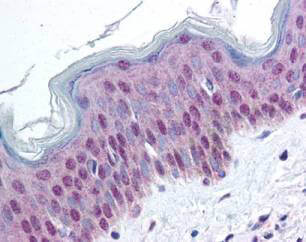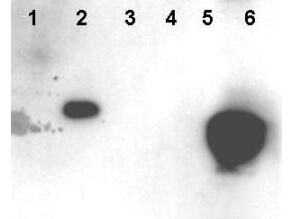HMGN phospho S20/S24 Antibody
Rabbit Polyclonal
$50.00 to US & $70.00 to Canada for most products. Final costs are calculated at checkout.
Background
This antibody is designed, produced, and validated as part of a collaboration between Rockland and the National Cancer Institute (NCI). HMGNs are proteins that bind chromatin effectively reducing the compaction of the chromatin fiber and enhancing access to DNA regulatory sequences. Members of this family have a conserved chromatin binding domain which is phosphorylated during mitosis. The sequence immunized is conserved in several species. As such, this reagent is designed as a ''universal'' reagent for the detection of all phosphorylated HMGN proteins. The High Mobility Group (HMG) proteins were originally isolated from mammalian cells and were named according to their electrophoretic mobility in polyacrylamide gels. HMGs were arbitrarily classed as a specific type of non-histone proteins based on the observation that they are ubiquitous to mammalian cells, that they share certain physical properties, and that they are associated with isolated chromatin. HMG proteins and are now subdivided into 3 families: the HMGB (formerly HMG-1/-2) family, the HMGN (formerly HMG-14/-17) family, and the HMGA (formerly HMG-I/Y/C) family. Each HMG family has a characteristic functional sequence motif. The functional motif of the HMGB family is called the ''HMG-box;'' that of the HMGN family, the ''nucleosomal binding domain;'' and that of the HMGA family, the ''AT-hook.'' The functional motifs characteristic of these canonical HMGs are widespread among nuclear proteins in a variety of organisms. Proteins containing any of these functional motifs embedded in their sequence are known as ''HMG motif proteins.'' Anti-HMGN pS20-pS24 Antibody is ideal for researchers interested in chromatin binding and Nuclear Signaling research.
Product Details
Target Details
Application Details
Formulation
Shipping & Handling
This product is for research use only and is not intended for therapeutic or diagnostic applications. Please contact a technical service representative for more information. All products of animal origin manufactured by Rockland Immunochemicals are derived from starting materials of North American origin. Collection was performed in United States Department of Agriculture (USDA) inspected facilities and all materials have been inspected and certified to be free of disease and suitable for exportation. All properties listed are typical characteristics and are not specifications. All suggestions and data are offered in good faith but without guarantee as conditions and methods of use of our products are beyond our control. All claims must be made within 30 days following the date of delivery. The prospective user must determine the suitability of our materials before adopting them on a commercial scale. Suggested uses of our products are not recommendations to use our products in violation of any patent or as a license under any patent of Rockland Immunochemicals, Inc. If you require a commercial license to use this material and do not have one, then return this material, unopened to: Rockland Inc., P.O. BOX 5199, Limerick, Pennsylvania, USA.


